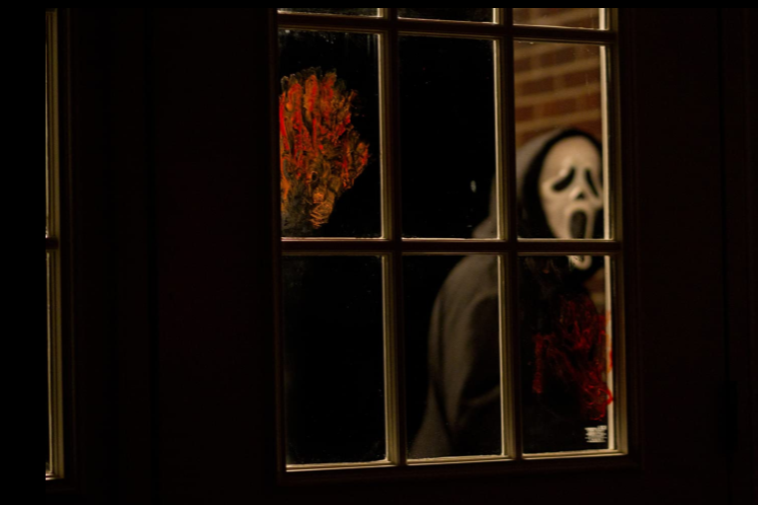It didn’t take long for the Scream franchise to become fully self-aware. At the midway point of 1996’s series opener, Jamie Kennedy’s film geek runs through the rules to survive a horror movie: Don’t have sex, don’t do drugs, don’t say “I’ll be right back.” Though Scream’s skewering of horror convention changed the way scary movies are made and consumed, it didn’t leave much room for intra-franchise progress. Scream 2 squeezes the last few liters of blood out of the old movie-within-a-movie conceit. The execrable Scream 3, which features both the “real” characters and “movie” doppelgängers from the cast of Stab 2, might as well have been filmed on a red-corn-syrup-slathered Möbius strip.
What does a movie franchise do when it starts to resemble a Borges story that’s been translated into English by Babel Fish and directed by Uwe Boll? Take a break for 11 years, then try again. Though critics and the movie’s ever-discerning characters refer to Scream 4 (Dimension) as a reboot, it’s more like a reversion—an abandonment of the New Scream formula in favor of Scream Classic. Kevin Williamson, who wrote Scream and Scream 2 before skipping out on the third, has returned for the fourth installment, and the action has moved back to Woodsboro, the site of the original massacre. As all scary movies should, Scream 4 puts craft ahead of cleverness—it knows when self-consciousness is a handy tool and when it’s a lazy crutch.
At this point, I will give the requisite spoiler warning: Though I wouldn’t dare give away the movie’s big finish, I can’t really talk about Scream 4 without revealing the opening sequence. OK, now that the spoiler police are gone, it’s time for me to undermine everything I’ve written so far: Scream 4 begins with a movie within a movie within a movie. In the opening sequence, two teenage girls get slaughtered by a Facebook stalker. This turns out to be the beginning of Stab 6—hey, it’s a sequel within a sequel—and a character played by Anna Paquin grouses that we’ve just seen “the death of horror right here in front of us.” Really, a Facebook stalker? Her friend (Kristen Bell) then stabs her in the stomach. This is the beginning of Stab 7, which is being watched by yet another set of teen girls (including Friday Night Lights’ Aimee Teegarden). Once they get killed, Scream 4 finally begins.
Along with revealing the producers’ commitment to filling the screen with as many young, attractive women as possible—actress reboot!—this three-part bloodbath is, I believe, an extended apology for the series’ misguided forays into post-postmodernism. “Stab 5 has time travel,” says Teegarden’s Jenny Randall, explaining that it’s “by far the worst.” While I suppose this could be interpreted as Lost mockery, or perhaps a shot at the legendary Amityville: It’s About Time, I’m sticking with my we’re-sorry-Scream 3-sucked theory.
Indeed, once Scream 4 casts aside sketch comedy in favor of an actual narrative, it manages to skewer sequeldom’s pitfalls without succumbing to them. This time around, Neve Campbell’s battered and bruised Sidney Prescott has returned to her hometown to promote a memoir about “leaving her victimhood behind.” Sidney moves in with her aunt and cousin Jill (Emma Roberts), whose high school crew—the requisite bad boy (Nico Tortorella), pair of movie nerds (Erik Knudsen and Rory Culkin), and popular-girl duo (Marielle Jaffe and Hayden Panettiere)—is soon menaced by the masked slasher Ghostface.
Scream 4 is not My Dinner With André—the dialogue often drifts from snappy to functional (has anyone ever said the word cyberspace out loud?) and the actors sometimes sound as if they’re still in rehearsal. The interactions between Courteney Cox’s newswoman Gale Weathers and David Arquette’s flatfoot Dewey are particularly stilted and unnaturalistic—it’s comic relief that’s a relief only when it stops. (One might venture that the actors’ marital troubles played a part in their performances, but they also stank in the other Scream movies.) The movie’s kiddie corps, though, is energetic and competent, and the fabulous Alison Brie adrenalizes the script in her bit part as Sidney’s gleefully foulmouthed book publicist. “Two girls butchered!” she shrieks, delighted by the PR possibilities. “Fuck me, wow!”
Youthful brio, expletives, and callbacks to 1996—the slasher-movie scholars proffer a list of rules for reboots, including the promise of a “third-act, main-cast blood bath”—wouldn’t be enough to carry Scream 4 if it weren’t for Wes Craven. The 71-year-old director knows how to make a scary movie—how pacing, lighting, music, and gaping chest wounds blend together to build dread and anticipation. Craven guides us expertly down a series of blind, bloody alleys, a journey that’s more pleasurable than frustrating. On account of his steady hand, the last act is as good as could be expected: skillfully conceived and entertaining in its preposterousness. It’s amazing that Williamson and Craven pulled it off, and the studio shouldn’t push its luck with another sequel. Of course, a strong opening weekend means Scream 5 won’t be far off. And, oh yes, there will be time travel.
